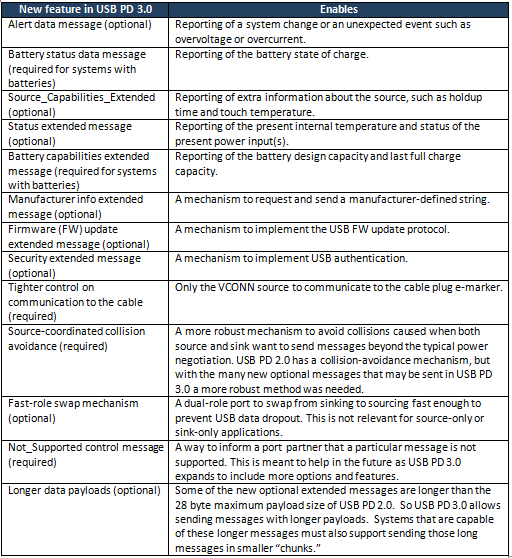SSZTB41 July 2016 TPS25740 , TPS25740A , TPS65982

Updated 4/16/2021: With the USB Implementers Forum (IF) standards body no longer certifying USB Power Delivery (PD) 2.0 silicon and end products, the time has come to move from USB PD 2.0 to USB PD 3.0. USB-IF certification provides products with the right to license the USB-IF Logo and ensures compliance with other USB certified end products and cables. Although Texas Instruments does not plan to end of life PD 2.0 devices, there is no longer a path to compliance using PD 2.0 silicon. USB PD 3.0’s expanded feature set and messaging have made it crucial to creating systems with USB PD. Let’s take a closer look at which features are specific to USB PD 3.0.
What to Gain in USB PD 3.0?
The main feature difference between USB PD 3.0 and USB PD 2.0 is the wide variety of optional messages that enable the source and sink to exchange more detailed and useful information. The required changes in USB PD 3.0 update the system to handle the larger number of these optional messages. These new messages do not interfere with negotiation and backward compatibility, and a USB PD 3.0 device is capable of negotiating with a USB PD 2.0 device. The source and sink message collision avoidance and the Not_Supported control message are two required changes that create a robust system which can work with these optional messages. The complete list of messages and changes can be seen below in Table 1.
Another new feature that comes with USB PD 3.0 is the Fast Role Swap (FRS) mechanism. With many systems needing the flexibility to be a Dual Role Port (DRP), there also comes the need to be able to switch between sourcing and sinking power fast enough that any USB data does not become corrupted nor video interrupted. FRS enables this quick change and protects the USB data in the process.
Table 1 lists the differences between the two versions as listed in the USB PD 3.0 specification.

|
Let’s dispel the erroneous thought that the voltage profiles or power rules are different between USB PD 2.0 and USB PD 3.0. The power rules are identical in both PD versions. The most important rules are:
- Sources offering more than 15W shall advertise 5V and 9V.
- Sources offering more than 27W shall advertise 5V, 9V and 15V.
- Sources offering more than 45W shall advertise 5V, 9V, 15V and 20V.
USB PD 3.0 ensures backwards compatibility with USB PD 2.0. All USB PD 3.0 sources and sinks are required to fully interoperate with USB PD 2.0 sources and sinks. This requirement is enforced by requiring all USB PD 3.0 devices to pass USB PD 2.0 compliance tests. From the USB-IF point of view, there are only USB PD products. The USB-IF does not distinguish between USB PD 2.0 products and USB PD 3.0 products when issuing USB logo certification.
TI offers many USB PD 3.0 compliant parts. Additionally, you can reach out to a device expert any time to help transition your system from USB PD 2.0 to 3.0 on our E2E forum.
Additional Resources
- Check out our device comparison and selection FAQ: "Selecting the Right USB Type-C PD IC"
- Start your design with these reference designs: